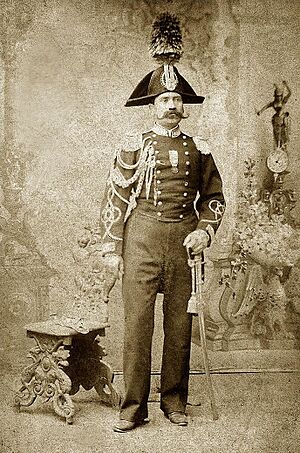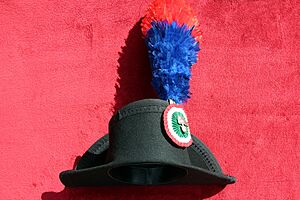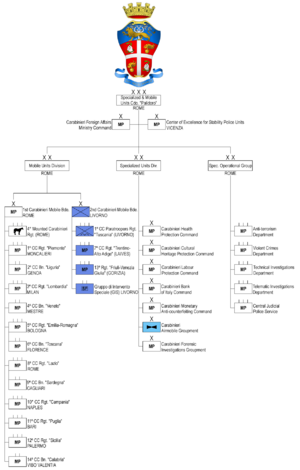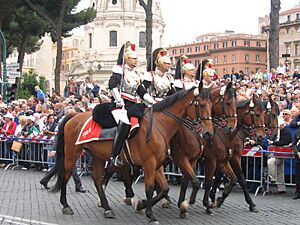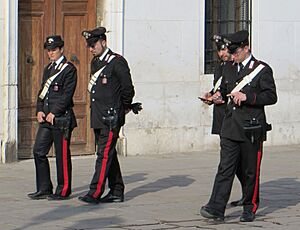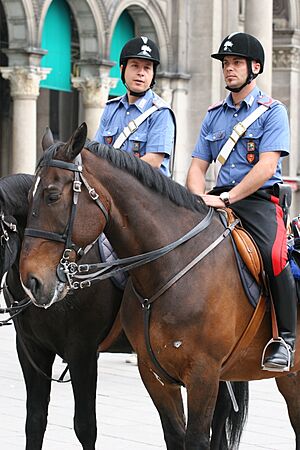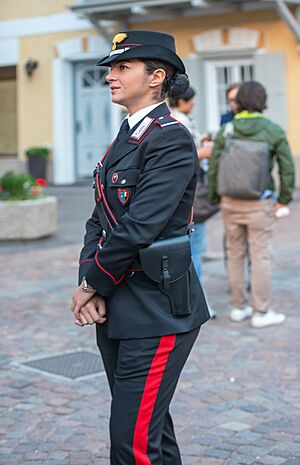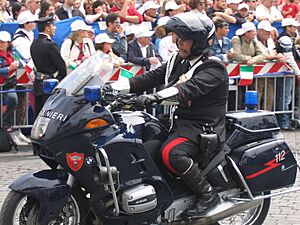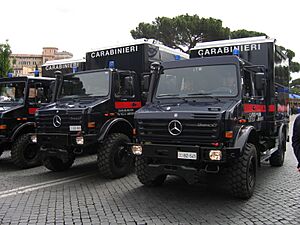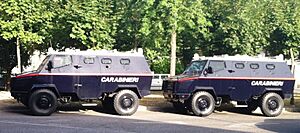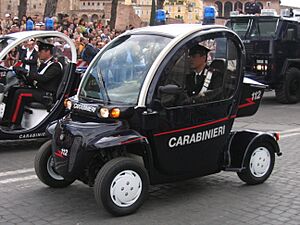Carabinieri facts for kids
Quick facts for kids CarabinieriArma dei Carabinieri |
|
|---|---|
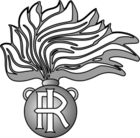
Emblem
|
|
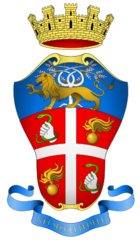
Heraldic achievement
|
|
| Motto | Nei Secoli Fedele Faithful through the centuries |
| Agency overview | |
| Formed | July 13, 1814 |
| Jurisdictional structure | |
| National agency | Italy |
| Operations jurisdiction | Italy |
| General nature | |
| Operational structure | |
| Headquarters | Rome |
| Sworn members | 110,000 officers |
| Elected officers responsible |
|
| Agency executive |
|
| Parent agency | Ministry of Defence Ministry of the Interior |
| Notables | |
| Anniversary |
|
| Website | |
| carabinieri.it | |
The Carabinieri (pronounced "kah-rah-bee-NYAIR-ee") are Italy's national police force. They do police work both in Italy and in other countries. They are one of Italy's most important police groups, along with the Polizia di Stato and the Guardia di Finanza.
Unlike the Polizia di Stato, the Carabinieri are part of the military. They are the fourth main part of the Italian Armed Forces. They work under the Ministry of Defence. For public safety in Italy, they also help the Ministry of the Interior. The Carabinieri often do similar jobs as the Polizia di Stato. You can reach both by calling 112, which is Europe's emergency number.
The Carabinieri also act as police for the military. Many of their members go on military missions in other countries. They were first created as the police force for the old Kingdom of Sardinia. This kingdom was a big part of Italy before it became one country. When Italy became united, the Carabinieri were named the "First Force" of the new military.
During the time of Benito Mussolini, the Carabinieri helped control people who opposed the government. However, they were also involved in his downfall. Many Carabinieri units were broken up by Nazi Germany during World War II. This led many Carabinieri to join the Italian resistance movement, fighting against the Nazis.
In 2000, the Carabinieri became their own separate part of the military. Before that, they were part of the Italian Army. Carabinieri officers can do police work anywhere in Italy, any time. They are always allowed to carry their assigned pistol, which is usually a Beretta 92FS.
People in Italy often call the Carabinieri "La Benemerita." This means "The Reputable" or "The Meritorious." It shows that they are a trusted and respected police group in Italy. This name was first officially used for them on June 24, 1864.
Contents
History of the Carabinieri
How the Carabinieri Started
The Carabinieri were created by King Victor Emmanuel I of Sardinia. He was inspired by the French police, called gendarmerie. The King wanted a police force for his Kingdom of Sardinia. Before this, police duties were handled by an older group called the Dragoni di Sardegna Corps.
After French soldiers left Turin in 1814, the Royal Carabinieri Corps was officially started. This happened with the King's special order on July 13, 1814. The name "Carabinieri" comes from the French word carabinier. This means a soldier who uses a type of rifle called a carbine.
The new police force was split into groups for each area (province). These groups were then divided into smaller companies. Even smaller units, called lieutenancies, managed local police stations. These stations were spread across the country to be close to the public.
In 1868, the Cuirassiers Regiment (or Corazzieri) was formed. They started as a special cavalry escort for the King. Since 1946, they have been the honor guard for the President of Italy. As Italy became one country, the number of Carabinieri groups grew. On January 24, 1861, the Carabinieri were named the "First Force" of Italy's new military.
In May 1915, during World War I, Italian troops moved into South Tyrol. This area belonged to Austria-Hungary, who were Italy's former allies. The Carabinieri's job was to act as "barrier troops." They set up machine gun posts behind the attacking soldiers. This was to stop soldiers from running away from the fight.
The 1930s and 1940s
During the time of Fascist Italy (1922–1943) under Benito Mussolini, the Carabinieri were one of the police forces used to control people who disagreed with the government. During World War II, they worked as military police. They fought against Allied forces and against Yugoslav fighters.
After Mussolini's government fell on July 25, 1943, the King ordered his arrest. Carabinieri officers arrested Mussolini as he left the King's home in Rome. They then held him prisoner. After Italy made a truce with the Allied forces on September 3, 1943, the country split. The fascist Italian Social Republic was in the north, and the Kingdom of Italy was in the south. The Carabinieri also split into two groups.
In the Kingdom of Italy, a Carabinieri Command was set up in Bari. They formed new units to help free Italy. These units fought with the Allied forces. In the fascist Social Republic in the North, a group called the National Republican Guard was formed. It included Carabinieri and other police officers. This group acted as military police and fought against resistance groups.
Because the Carabinieri helped remove Mussolini, the Germans did not trust them. On October 6, 1943, the Germans disarmed the Carabinieri. They sent 8,000 officers to Germany for forced labor. Later, many Carabinieri joined the Italian resistance movement. They fought against German and Italian fascists.
After the war, over 2,700 Carabinieri had died and 6,500 were wounded. This was out of about 14,000 who joined the Resistance. One brave act was by Vice Brigadiere Salvo D'Acquisto. He was executed by Nazi Germany during World War II. He gave his life to save other citizens who were about to be executed. He claimed he was responsible for something he didn't do to save them.
The Carabinieri Today

The Carabinieri played a big role in many conflicts in Italy in the late 20th century. For example, during the "Years of Lead" when there was a lot of political violence. Until 2000, the Carabinieri were part of the Italian Army. On March 31, 2000, they became the fourth separate branch of the Italian Armed Forces.
Interpol says that the Carabinieri investigate crimes all over Italy. They also act as military police for the Italian armed forces. They can be called upon for national defense. Europol (the EU's police agency) says their military duties include helping with national defense. They also take part in military operations in Italy and abroad. They protect Italian embassies in other countries.
As a national police force, they keep public order and safety. They also investigate crimes on their own or when asked by judges. Europol also notes that special Carabinieri groups protect important community interests. These include protecting the environment, health, and Italy's cultural treasures. They also stop fake money from being made.
In recent years, Carabinieri units have been sent on peacekeeping missions. These include missions in Kosovo, Afghanistan, and Iraq. In 2004, the Carabinieri were asked to create a special center. This center helps train civilian police units for international peacekeeping missions.
The State Forestry Corps was closed on December 31, 2016. Its staff who worked as forestry police joined the Carabinieri.
How the Carabinieri are Organized
The Carabinieri are led by the Comando (Command). This includes the Comandante Generale (a General) and the Vice-Comandante Generale (a Lieutenant General). There is also a Chief of Staff. All of these leaders are located in Rome. The Chief of Staff guides and checks all the force's activities.
Local Organization
The Carabinieri are set up across the country to handle law enforcement. This local organization is the main part of the force. It includes 80 percent of all Carabinieri members. It is organized in a chain of command:
- Five inter-regional commands
- 19 regional commands
- 102 provincial commands
- 504 Company Commands
- 4,672 Station Commands and lieutenancies
The local organization also has four special units that use helicopters:
- Carabinieri Heliborne Squadron "Cacciatori di Calabria", for operations in Calabria
- Carabinieri Heliborne Squadron "Cacciatori di Sicilia", for operations in Sicily
- Carabinieri Heliborne Squadron "Cacciatori di Sardegna", for operations in Sardinia
- Carabinieri Heliborne Squadron "Cacciatori di Puglia", for operations in Apulia
Special and Mobile Units Command
Separate from the local organization, there is the Specialist and Mobile Units Command Palidoro. This command is based in Rome. It controls the Carabinieri Mobile Units Division, the Carabinieri Specialist Units Division, and the ROS.
Carabinieri Specialist Units Division
This division was created in 2001. It handles special police activities and helps the local Carabinieri groups. It leads and checks its own units. These units protect Italian art, stop fake money, and guard Italian embassies abroad. They also protect health, police labor laws, and help the Bank of Italy. This division also provides air support for the Carabinieri.
Mobile Units Division
The Carabinieri Mobile Units Division is in Rome. It has two brigades that handle large operations during emergencies. They also defend the country and take part in military missions abroad. They help keep public order in cities. They also support civil authorities in public safety.
The 1st Mobile Brigade is in Rome. It has six Regiments and four Battalions. These are mainly used for public order tasks. The 2nd Mobile Brigade is in Livorno. It includes the Gruppo di Intervento Speciale (a special forces group). It also has the 1st Paratroopers Carabinieri Regiment "Tuscania", and the 7th "Trentino-Alto Adige" and 13th "Friuli-Venezia Giulia" regiments. These units, along with the Multinational Specialized Unit, are mostly involved in international missions.
Special Forces
The Gruppo di Intervento Speciale (GIS) is one of Italy's six special forces groups.
ROS (Special Operational Group)
The ROS (Raggruppamento Operativo Speciale) is an elite unit. It was started in 1990. Its job is to deal with organised crime (like the Mafia), terrorist activities, and other complex crimes. There is an anti-crime section of the ROS in every major city.
Special Tasks Departments
Special Tasks Departments work outside the usual organization. They are used for special missions: The Corazzieri (Cuirassiers) are an elite group. They are the honor guard for the President of the Italian Republic. They are based in the Quirinal Palace. They are known for their special uniforms and for being very tall (at least 1.9 meters or 6 feet 3 inches). They mostly do ceremonial duties.
Other departments serve important government bodies. These include the President's office, the Senate, Parliament, and the courts. Carabinieri also do military police work and security for the Ministry of Defence. They also work for military commands and allied military groups in Italy and abroad. They also have staff in anti-Mafia and anti-drug groups. Carabinieri officers also provide security at Italian embassies and consulates in other countries.
Along with the Polizia di Stato and the Guardia di Finanza, the Carabinieri also help with border control.
Command Unit for Environmental, Agri-food, and Forestry Protection
This special unit is called Comando unità per la tutela forestale, ambientale, e agroalimentare. Its main office is in Rome. It has 15 regional commands and about 700 local stations across the country. It has 7,000 staff members. Its jobs include stopping illegal food production and distribution. It also protects the environment and wildlife. It works to stop poaching and criminal groups that harm the environment. This unit also has 29 NOEs (Nucleo Operativo Ecologico). These are teams that specialize in complex investigations against organized crime that affects the environment.
War Service
The Carabinieri took part in many important battles before World War I:
- Grenoble, July 5, 1815
- Battle of Pastrengo, April 30, 1848 – they won their first Silver Medal of Military Valor
- Battle of Santa Lucia, May 6, 1848 – they won their first Bronze Medal of Military Valor
- Battle of Custoza, July 24–25, 1848
- Battle of Custoza, June 24, 1866
- Capture of Rome, September 20, 1870 (with the Bersaglieri)
For their help in World War I, the Carabinieri won their first Gold Medal of Military Valor.
In World War II, Carabinieri fought in these battles:
- Battle of Klisoura on the Greek-Albanian front, December 16–30, 1940 – won a Bronze Medal of Military Valor
- Battle at Cafe Struga on the Albanian-Yugoslav front, April 18, 1941
- Battle of Culqualber (Ethiopia), August 6 – November 21, 1941 – won their second Gold Medal of Military Valor
From 1943 to 1945, the Carabinieri worked under the Allied Military Government. Their reorganization was helped by Colonel Arthur Young, a British police officer.
Carabinieri Uniforms
The Carabinieri, as a military and police force, have many different uniforms. They wear different uniforms for different jobs and seasons. There are also versions for men and women. The rules for when and how to wear them are in a special book called the "R-11 "Regulation on Uniforms for the Carabinieri Arma".
The Carabinieri uniforms are divided into:
- Historical and full dress
- Ordinary (everyday)
- Service (for specific duties)
- Representative (for formal events)
- Great Winter Uniform (GUI) / Great Summer Uniform (GUE) (for officers)
- Operational use (for active missions)
- Athletic gear (for sports)
The service, representative, and GUI/GUE uniforms are based on the ordinary uniform.
History of Uniforms
When they first started, the Carabinieri wore a special black uniform. It had silver trim around the collar and cuffs, red edges, and silver shoulder pads. The mounted (horseback) police had white fringes, and the walking police had light blue. Their hat was a unique two-pointed hat called the lucerna. They still use a version of this old uniform for ceremonies today.
In 1814, the uniform was a turquoise suit with a blue collar. Over the years, small changes were made. Officers had silver swords. In the early 1900s, during World War I, rules for uniforms became stricter.
Soldiers had three types of uniforms: Complete, Ordinary, and Effort. At that time, the Carabinieri's everyday uniform was made of a green-grey fabric, like other soldiers.
Historical and Ceremonial Uniform
For special events and historical displays, the Carabinieri wear a unique black uniform. It has silver braids around the collar and cuffs, red edges, and silver shoulder pads. The mounted police have white fringes, and the infantry has light blue. They wear the traditional two-pointed hat, the Lucerna (or bicorne).
In the 1980s, famous designer Giorgio Armani designed some of the new, more modern uniforms.
Ordinary (Everyday) Uniform
The modern everyday Carabinieri uniform is black for all seasons. It has small changes for different weather, like a coat or wind jacket. It includes:
- A four-button jacket with shoulder pads. All buttons are silver.
- A white shirt underneath with two pockets.
- Classic-cut trousers with four pockets. They have two red stripes down the sides from hips to ankles.
- Flat black shoes.
The uniform also comes with accessories:
- A black tie.
- A white cross-belt, or Sam Browne belt, or no belt.
- A peaked cap (for males) or bowler cap (for females).
- Black leather gloves.
- A V-neck sweater.
- A wind-breaker.
- A waterproof coat.
There are differences based on the season, duties, rank, and location. For example, in summer, the jacket, white shirt, and tie are replaced with a short-sleeved blue shirt.
In cold weather, they can wear a waterproof coat. Inside buildings, the jacket can be taken off or replaced with a V-neck sweater.
In 2020, new "bomber-style jackets" with logos were added. These can be worn instead of the four-button jacket. The white cross belt is still worn over them. A roll-neck shirt or a white shirt and tie can be worn underneath.
Newer, cut-resistant gloves have replaced the old leather ones. A new external belt with a quick-release holster is also used.
Headwear
The standard peaked cap is stiff. It has a Carabinieri emblem (frieze) on it. The emblem is metallic for new recruits and students. It's silver for non-commissioned officers (NCOs) and gold for inspectors and officers. Generals have a special eagle emblem.
The cap is black. It has a chin strap held by two buttons. The strap is black for lower ranks. For higher ranks, it becomes silver with black patterns. For marshals, it's silver with red edges and silver braids. For generals, it's a silver braid.
Other hats include berets and mountain-style caps. Carabinieri military police units wear a dark navy blue beret.
Service Uniform
The service uniform is similar to the ordinary uniform. But it is changed for the specific job the officer is doing.
For example:
- For mountain areas, they wear ski patrol gear.
- For horseback patrol, they wear different boots.
- For car patrol, they wear different boots and carry a "paletta" (a stop sign for vehicles).
Representative (Dress) Uniform
(For carabinieri, NCOs, warrant officers, officers.)
This uniform is like the ordinary uniform but for more formal events. It is worn when the ordinary or ceremonial uniforms are not suitable. It has these differences:
- White cords (agiluettes) on the jacket.
- A sabre (sword) with special attachments.
- A black belt with a shoulder strap (for marshals and chief brigadiers) or a white cross-belt (for others).
- White gloves.
- A black cape in colder weather.
Sometimes the pistol is worn with the sword, sometimes not. The peaked cap is worn with this uniform.
Operational Uniform
This uniform is worn for active operations. These include public order (riot) situations, raids, and cross-country work. It is blue with red trim and has a "Polychrome" pattern.
It includes:
- A jacket (with four pockets, shoulder straps, and thermal lining) and trousers.
- A blue fleece suit (instead of a sweater).
- A blue neckerchief with red trim.
- Black leather gloves with extra protection.
- Black ankle boots for rough terrain.
- A dark-blue beret with the cap badge.
A special version of this uniform is worn by the Special Intervention Group. Also, the "Tuscania" Parachute Regiment, Carabinieri Regiment on Horseback, and Airborne Squadrons CC Cacciatori wear it. Their uniforms often have camouflage colors instead of blue and red. Their berets are maroon/red instead of blue.
Riot helmets, body armor, and other protective gear are worn when needed.
Gymnastic (Athletic) Uniform
This uniform is for sports. It includes a tracksuit (jacket and pants), a T-shirt, and shorts.
The tracksuit is blue with red parts. The jacket has a central zipper and removable sleeves. The pants have an elastic waist and zippers at the bottom. The jacket, T-shirt, and shorts all have the Carabinieri emblem.
Other Uniforms
There are also evening-dress uniforms (mess kit) for dinners and galas. There are also variations for other occasions, like when medals or sabres need to be worn.
Female Uniforms
Uniforms for female staff are mostly adaptations of the male uniforms.
The differences include how the jackets button and their shape (without upper pockets). Women can also wear skirts in offices or for formal events. Shoes are also different.
Other clothing and equipment items are the same as for male staff.
Decorations and Awards
The Carabinieri's official flag has received many awards:
- 6 Cavalier Crosses of the Military Order of Italy
- 3 Gold Medals of Military Valor
- 3 Gold Medals of Army Valor
- 5 Silver Medals of Military Valor
- 4 Bronze Medals of Military Valor
- 11 Gold Medals of Civil Valor
- 1 Silver Medal of Civil Valor
- 2 War Crosses of Military Valor
- 4 Gold Medals of Civil Merit
- 6 Gold Medals for Public Security
- 6 Gold Medals for Service to Education, Culture, and Arts
- 2 Gold Medals for Service to the Environment
- 1 Gold Medal for Service in the Earthquake of 1909
- 1 Bronze Medal of Civil Defense Excellence 1st Class
Weapons Used
The Carabinieri use different types of weapons. Some are given to each officer (individual weapons). Others are given to each unit or department (departmental weapons). Departmental weapons can be ordinary (for all units) or special (for specialized units only).
Individual Weapons:
- Beretta 92 pistol (SB and FS versions): For carabinieri, superintendents, and inspectors.
- Beretta 8000 pistol: Only for officers.
- Beretta Px4 Storm pistol: Replacing the Cougar 8000 for officers.
Ordinary Departmental Weapons:

- Beretta PM12-S2 submachine gun: Being phased out.
- Beretta PMX submachine gun: Introduced in June 2019 to replace the PM12.
- Franchi Spas 15 MIL smoothbore combat shotgun.
- Beretta 70/90 assault rifle (AR and SCP versions): Used by special regiments, being phased out.
- Beretta ARX-160A3 assault rifle: Introduced in 2018. It is replacing the AR 70/90 in special units and training departments.
Special Weapons:
- Glock 17 pistol: Used by the GIS special forces.
- M4 carbine: Used by Tuscania and GIS.
- Heckler & Koch MP5 submachine gun: Used by GIS, Tuscania, and Hunting Squadrons.
- Mauser Sp 66 sniper rifle: Used by snipers and GIS.
- Accuracy International AWP sniper rifle: Used by sharpshooters and GIS.
- Beretta MG 42/59 squad assault machine gun: Used by Naval Service and special regiments.
- FN Minimi light machine gun: Used by special regiments.
Vehicles and Equipment
Until recently, Italian police only used Italian-made vehicles. Now, they also use Land Rover Defenders and Subarus. Regular Carabinieri patrol cars are dark blue with a white roof and a red stripe. Carabinieri license plates start with "CC". A Carabinieri car is often called a Gazzella (gazelle). Smaller cars are for regular patrols. Larger, more powerful vehicles are for emergencies, highway patrol, and special services. Military police and mobile unit vehicles are painted in military camouflage.
Cars
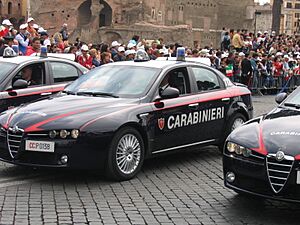

- Alfa Romeo 159
- Alfa Romeo Giulia
- Alfa Romeo Giulietta
- Subaru Forester
- Lancia Kappa
- Land Rover Freelander
- Land Rover Defender-90 hard top
- Land Rover Discovery II, III, and IV
- Lotus Evora S
- Fiat Ducato
- Hummer H1
- Fiat Grande Punto
- Fiat Tipo (2015)
- Jeep Renegade
- Jeep Grand Cherokee
- Mitsubishi Pajero
- Mitsubishi i-MiEV
- Isuzu D-Max
- Renault Clio
- Iveco Daily
- SEAT León
- Suzuki Jimny
Motorcycles
- Moto Guzzi California Cruiser
- BMW F650GS
- BMW R1100-RTP
- BSA M20
Aircraft
- Fixed-wing aircraft:
- Helicopters:
- AgustaWestland AW109
- Agusta-Bell AB 412
- AgustaWestland AW139 (since 2019)
Tactical Vehicles
- Land Rover Defender 110 soft top
- Iveco Daily 4×4 40.10WM (light armored military truck)
- Unimog
- RG-12
- Iveco VM 90T Torpedo
- Iveco VM 90P Protected
- Iveco LMV
- Puma 4×4
- Puma 6×6
- VCC1
- M113
- M3
- Hummer H1
Ships
- Offshore patrol boats:
- Motovedetta classe 800
- Motovedetta classe N700
- Motovedetta classe 600
- Coastal patrol boats:
- Motovedetta classe 200
- Motovedetta classe 100
- Motorboats:
- Motovedetta classe 300
- Motovedetta classe N100
- Motovedetta classe T120
- Motovedette classe S
- Battello pneumatico Stinger
Special Vehicles
- GEMCAR
- Snowmobile Polaris
Images for kids
See also
- Italian Carabinieri Bands
- Civilian control of the military
- Corps of Gendarmerie of Vatican City
- Gendarmerie
- Law enforcement in Italy
- Military police
- Multinational Specialized Unit
- Zaptie
- Carlo Alberto Dalla Chiesa
- Centro Sportivo Carabinieri


